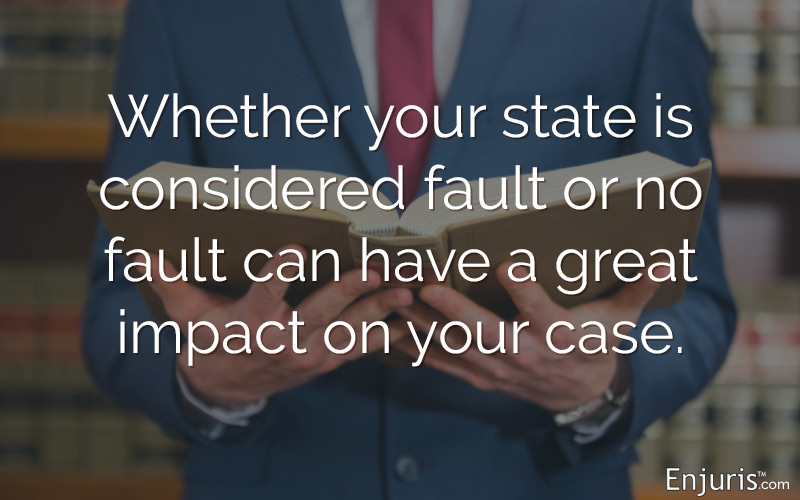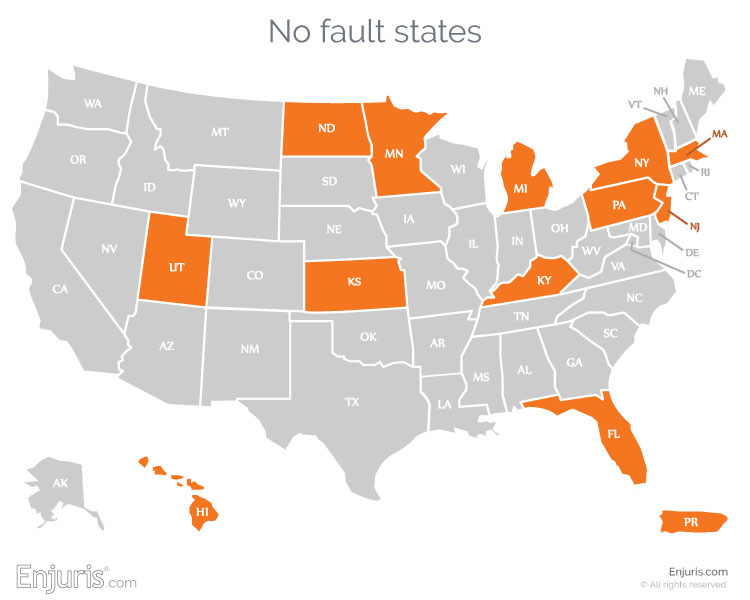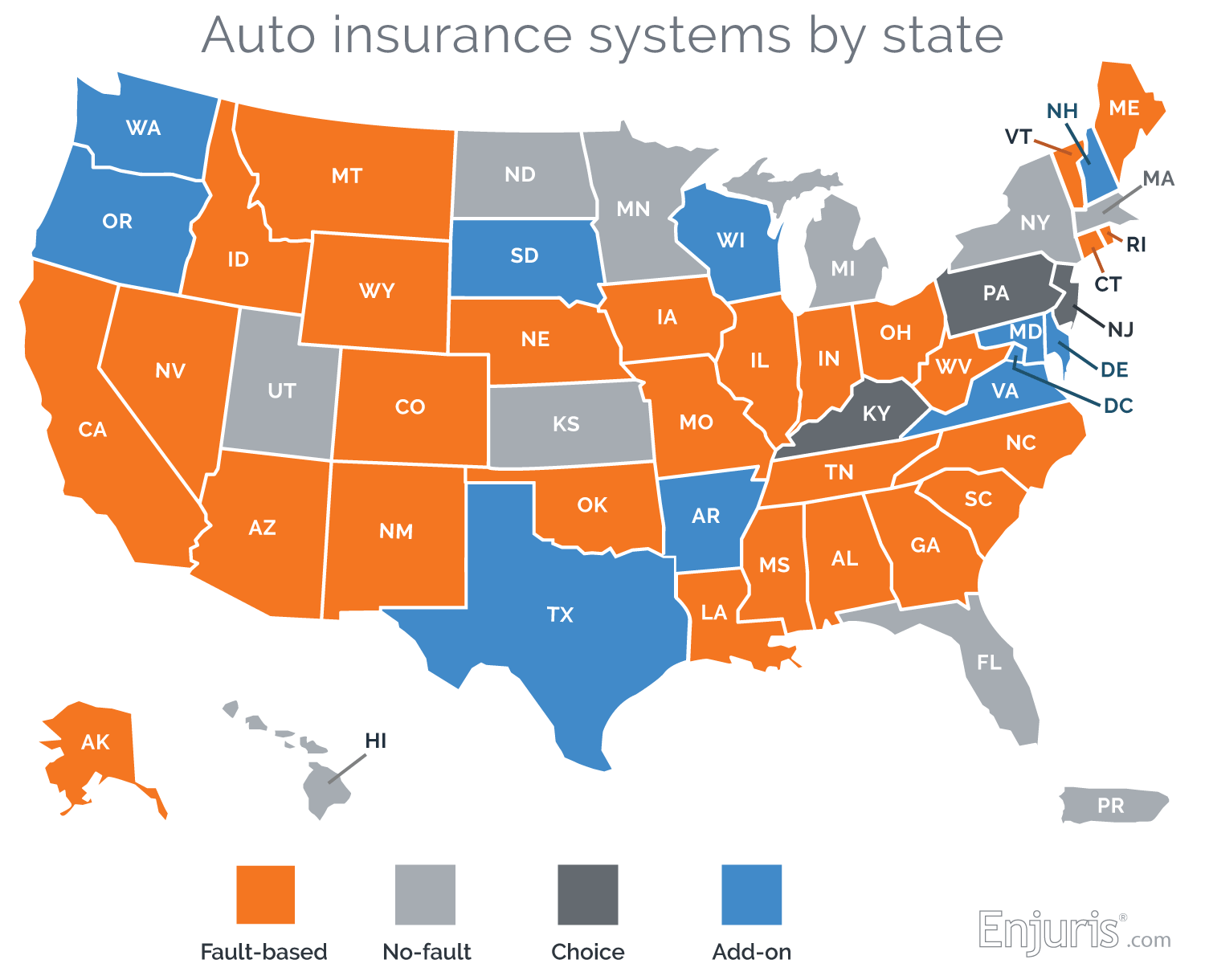
What is a no-fault insurance claim? Learn the difference between no-fault insurance and fault-based insurance.
Approximately 87% of drivers in the United States have some form of auto insurance, according to the Insurance Research Council (IRC).
If you’re involved in a car accident, the chances are pretty good that an insurance policy will come into play. In most states, the driver who caused the accident will be responsible for the damages. In other words, you’ll file a claim with the at-fault driver’s insurance company.
However, in a handful of states, the process for recovering damages after a car accident is completely different.
Let’s take a look at the different types of auto insurance systems, with a focus on no-fault auto insurance laws.
The different auto insurance systems, explained
Every state has its own auto insurance laws that determine how a car accident victim can receive compensation. These auto insurance laws can roughly be divided into 4 types:
- Fault-based insurance systems (sometimes called “tort systems”). In a conventional fault-based insurance system, a victim receives compensation from another party (or their insurance company) if the victim can prove that the other party was responsible for the accident.In states that follow a conventional fault-based system, drivers purchase liability insurance to protect themselves from having to pay for damages that result from accidents they cause.
- No-fault insurance systems. In states with a no-fault insurance system, all drivers in an accident—regardless of who’s responsible—turn to their own insurance policies to cover the damages. In a pure no-fault insurance system, it’s not possible (or usually necessary) to sue the other party for their damages. In states that follow a no-fault insurance system, drivers can sue for severe injuries if the case meets certain conditions. These conditions are known as the “tort liability threshold.” For example, a state may allow drivers to sue if the accident results in death or if the damages exceed some monetary threshold.
- Choice-based insurance systems. In states that have a choice-based insurance system, each driver is permitted to choose whether to be a part of a fault-based insurance system or a no-fault insurance system.
- Add-on insurance system. In states with an add-on insurance system, drivers are free to sue the at-fault party (just like in fault-based insurance systems), but can also add first-party coverage if they prefer that their own insurance company pay for certain expenses.
History of no-fault insurance systems
For people who live in states that follow fault-based insurance systems, no-fault insurance systems can seem very strange. Let’s take a look at how they came about.
No-fault insurance systems were largely a response to dissatisfaction with fault-based insurance systems. Drivers and insurance companies felt that too much time and money was being spent to determine who was at fault following a car accident.
Several states sought to address this dissatisfaction by allowing car accident victims to recover damages from their own insurance companies.
In 1971, Massachusetts became the first state to adopt a no-fault insurance system (although Puerto Rico passed a no-fault insurance law in 1968).
Following in the footsteps of Massachusetts, no-fault laws were enacted in 16 states. However, 4 of those states later repealed their no-fault laws.
Today, 12 states have some form of no-fault insurance.

These states also require that automobile insurance policies include personal injury protection (PIP).
How no-fault insurance works
In no-fault states, the laws were passed in order to take small claims out of the court system. As insurance companies (and others) discuss fault systems, they’ll use these terms:
- First party. The insurance company’s own policyholder.
- Second party. The insurance company.
- Third party. Anyone else injured in the accident.
The insurance company provides compensation to its own policyholder (the first party) after an accident, regardless of who was at fault.
A driver in a no-fault state is required to carry PIP coverage, though coverage varies by state. However, if the injuries are severe, sometimes a driver can sue, even in a no-fault state.
In a no-fault state, each party in a car accident makes a claim against their own insurance policy regardless of which party was at fault for the accident.
Benefits of no-fault insurance
The major downside to no-fault insurance in states that follow the pure no-fault insurance system is that you can’t sue the at-fault driver. This is typically only a problem if you’re involved in a serious car accident.
Consider the following example:
When the accident occurred, Kelly had a $500,000 auto insurance policy. However, Kelly’s medical expenses (including the cost of the future around-the-clock care she’ll need as a result of the accident) total more than $5 million.
Unfortunately, Kelly lives in a no-fault insurance state, which means her recovery is limited to the $500,000 policy and she cannot sue the at-fault driver for the damages that exceed her policy limits.
There are, however, a number of benefits that no-fault insurance systems provide. For example:
- Fewer lawsuits. No-fault insurance means that car accident victims don’t have to go through emotionally and financially draining litigation.
- Quick payouts. Because fault is irrelevant in no-fault insurance systems, car accident victims in these states typically receive a faster insurance payout than they would in states that follow a fault-based insurance system.
- Broad coverage. In addition to medical expenses, no-fault insurance coverage typically covers things like funeral expenses, lost wages, childcare expenses, and even some household services.
Essentially, the no-fault system takes small claims from car accidents out of the courts and limits the ability to sue by adding an insurance-based way for an injured person to recover costs.
How do I file a claim in a no-fault insurance state?
If you’re in an accident and have no-fault insurance, you should contact your insurance company immediately to file a claim. When you speak to your insurance agent, be honest and promptly submit all the paperwork they request.
Keep in mind that no-fault insurance coverage only covers physical injuries that result from an accident. If your vehicle is damaged in an accident in a no-fault state, the at-fault driver will be responsible for paying for your vehicle damages through their property damage liability insurance.
How do I file a claim in a fault-based insurance state?
If you’re in an accident in a fault-based insurance state, there are 3 ways to recover damages following the accident:
- File an insurance claim with your own insurance company. In this scenario, your insurance company will pay the claim (assuming there’s coverage) and then seek reimbursement (called “subrogation”) from the at-fault driver’s insurance company.
- File an insurance claim with the at-fault driver’s insurance company. When filing an insurance claim with the at-fault driver’s insurance, be careful about what you say. Remember, the insurance company will be looking for ways to avoid paying the claim.
- File a personal injury lawsuit against the at-fault driver. In this scenario, the at-fault driver’s insurance company has a legal obligation to defend the at-fault driver (assuming there’s coverage). As a result, the insurance company will likely join the lawsuit and settle or defend the matter.
Keep in mind that, in fault-based states, you need to prove that the party was legally responsible for your accident. In most cases, this means establishing the elements of negligence:
- Duty. You must prove that the defendant owed you a duty of care. All drivers owe all others on the road a duty to exercise reasonable care to avoid harming others.
- Breach. You must prove that the defendant breached their duty of care. A breach occurs when the defendant fails to meet the standard of care required (for example, running a red light).
- Causation. The plaintiff must prove that their injury was caused by the defendant’s breach of the standard of care.
Is your state a no-fault insurance state?
Now that you understand how no-fault insurance works, let’s take a look at which states have adopted the no-fault insurance system.

| Auto insurance systems by state | |||
|---|---|---|---|
| Fault-based | No-fault | Choice | Add-on |
| Alabama Alaska Arizona California Colorado Connecticut Georgia Idaho Indiana Illinois Iowa Louisiana Maine Mississippi Missouri Montana Nebraska New Mexico Nevada North Carolina Ohio Oklahoma Rhode Island South Carolina Tennessee Vermont West Virginia Wyoming |
Florida Hawaii Kansas Massachusetts Michigan Minnesota New York North Dakota Puerto Rico Utah |
Kentucky New Jersey Pennsylvania |
Arkansas Delaware District of Columbia Maryland New Hampshire Oregon South Dakota Texas Virginia Washington Wisconsin |
Ready to meet with an attorney to discuss your car accident claim? Enjuris can help you find an experienced car accident lawyer near you.
Connect to top-rated lawyers in seconds using our comprehensive national directory
See our guide Choosing a personal injury attorney.
